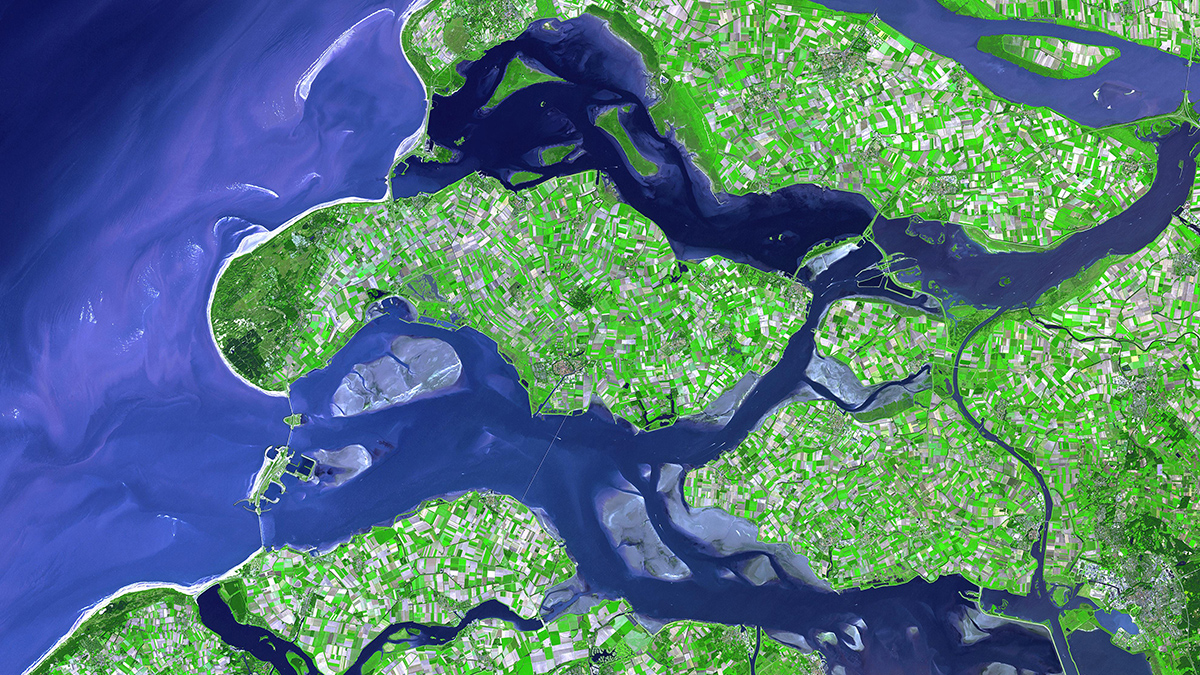
This is an audio story from Eos, your trusted source for Earth and space science news. Do you like this feature? Let us know in the comments or at [email protected].
TRANSCRIPT
Emily Gardner: Before Chelsea Clifford was an environmental scientist, she was a college student, working at White Mountain Research Center at UCLA, studying bugs.
Chelsea Clifford: While everyone else was doing really glamorous fieldwork in Yosemite, Kings Canyon, places like that, I was borrowing my aunt’s ex-husband’s ’91 manual transmission Honda Civic. I didn’t really know how to do manual and was scared of taking it up in the mountains. And so, when I had the opportunity to do independent research, I had gotten kind of fascinated staring out the window all that summer at these weird decorative ditches they had in the desert, diverted from the irrigation ditches into people’s backyards in the fancier suburbs.
Gardner: Clifford set out to study the invertebrate communities in these ditches, to see how they compared to the communities in natural creeks. That work sent her down a rabbit hole, and she’s still going down.
(The sound of running water fades in).
If you’ve never really thought about ditches, you’re not alone. In fact, according to a new paper written by Clifford and dozens of other researchers, most scientists don’t think about them either. Here’s AJ Reisinger, a freshwater ecosystem ecologist and biogeochemist at the University of Florida, who was not an author of the paper.
Reisinger: I do think that ditches are understudied, particularly in terms of their ecological and environmental implications. I think that’s largely driven by the artificial nature of ditches and the fact that ecologists tend to gravitate towards natural settings, natural ecosystems, natural environments. That’s why we get into ecology in the first place, because we’re interested in the environment. And so the artificial nature of ditches kind of precludes a lot of people from being interested or wanting to work in those areas often, I think.
Gardner: And that’s a problem, some scientists say. Because ditches do more than just carry water: They can be sources or sinks of nutrients, transport pollutants, host distinct ecosystems, and even emit greenhouse gases. This is why Clifford and dozens of other scientists came together in 2023 for a workshop to raise the profile of ditch research. The group included biogeochemists, ecologists, biologists, and even archaeologists. They published a perspective paper on their work in Communications Earth and Environment.
Among these self-described “ditchologists” was Michael Peacock, a biogeochemist at the University of Liverpool, where the workshop was held, and the Swedish University of Agricultural Sciences in Uppsala. He and Clifford led this paper together. They started out by—after much discussion—defining a ditch.
Peacock: I think we settled on the definition of a ditch for the paper was a linear constructed waterway that is usually filled with water and is aiming to take that water somewhere else, wherever people want it to go.
Gardner: In addition, ditches are usually narrower than 25 meters across. “Ditch” is also sort of a catchall term. Ditches used for irrigation might be called gripes, catchwaters, or dikes, whereas ditches used for transport might be called canals or waterways, for instance. As the paper points out, people might reach for these words because the word “ditch” has something of a negative connotation. To “ditch” also means “to abandon.” There’s also “dull as ditchwater” and “last-ditch efforts.”
Then the researchers laid out several of the reasons why ditches matter. Clifford gave the example of her hometown, Gloucester, Va., a sea level rise hot spot near the Chesapeake Bay. When saltwater intrusion occurs, it tends to reach ditches first, and is then transported further inland, compromising the freshwater used for crop irrigation or even drinking. Saltwater intrusion can also cause marsh migration, in which salt-tolerant crops move farther inland, and sometimes interfere with agriculture.
Clifford: Basically, what’s happening to the landscape as a whole is often happening to ditches first. Ditches are often headwaters of larger water bodies. So water may, you know, pass through them before going further downstream. So that can be a good spot to monitor and potentially intervene before there are larger issues.
Gardner: The paper points out that ditches can transport materials including microplastics, pharmaceuticals, pesticides, trace metals, pathogens, and PFAS [per- and polyfluoroalkyl substances]. These can affect humans, of course, and also the animal and plant communities in and around ditches.
Gea van der Lee is an aquatic ecology researcher at Wageningen University [and Research] in the Netherlands—a nation home to more than 300,000 kilometers, or about 186,000 miles, of ditches, or canals. In the Netherlands, she said, ditches are seen as a way to drain the land, but their role as a space for biodiversity is overlooked: They host bugs, plants, amphibians, and other animal life. A few years ago, she led a project that found that recording the sounds made in ditches can improve understanding of metabolism in ditches, because it can capture low-frequency sounds, like these, that may correspond to photosynthesis.
(A few seconds of a low-pitched sound play.)
Here’s van der Lee.
Reading List
Lines in the Landscape
(Communications Earth and Environment paper)
Freshwater ecoacoustics: Listening to the ecological status of multi-stressed lowland waters
(Ecological Indicators paper by Gea van der Lee & colleagues)
van der Lee: I found it really nice to be together with because there’s not so many people working on ditches, and then you come together with [a] whole group of ditch nerds that are really excited about ditches.
Gardner: Of course, outside of countries like the Netherlands, ditches don’t always take up a lot of room in the landscape. But Peacock offered a biogeochemistry perspective on why ditches still shouldn’t be overlooked.
Peacock: Generally, they’re small, and we ignore them, but we know they emit a lot of greenhouse gases, particularly methane, and they can sort of exert overwhelming effects on the ecosystem-scale methane balance.
You might have a field that is drained with ditches and the field is a net sink of methane because it’s dry. But the ditches, because they’re wet, which is where the bugs that make methane like to live, the ditches emit loads of methane. And if you add up the ditches and the fields, sometimes the ditches overwhelm the fields, and the landscape can be a small net source of methane. And you would never know that if you didn’t go and look at the ditches.
Gardner: Jeremy Biggs, a freshwater biologist, CEO of the Freshwater Habitats Trust, and visiting professor at Oxford Brookes University, who was also not involved in the paper, said this effort felt timely.
Biggs: It feels quite familiar to me because it feels like the same, the same kind of approach, the same line that we’ve taken with ponds and small waters more generally, that they’ve been neglected and overlooked.
Gardner: “Small waters” include freshwaters like ponds, headwater streams, springs, seepages, and of course ditches. They’re often ignored by researchers and regulators, Biggs said, simply because they’re small.
Biggs: We just assume small things are unimportant. And everyone just assumes that a big lake is more important than a small one and a big river is more important than a small one, and that’s why they’re not in regulations, in essence. But there’s a lot of them. That’s the thing. You don’t notice them, but there’s a lot of them.
Gardner: In earlier work, Peacock came up with the rough estimate that drainage ditches alone may cover up to 10.7 million hectares, or 26 million acres, globally. All this area means there’s also a lot of life in small waters.
Biggs: Although their individual site richness, or what ecologists call alpha diversity, is less than it is for a bigger water body, just as you’d expect, when you put them together in networks, it quite often turns out that they support more species collectively than do the bigger water bodies.
Gardner: Biggs is talking about standing waters and headwater streams here, but because headwater streams are a close proxy to ditches, he said he wouldn’t be surprised if the same was true for ditches, too. Ditches are home to communities of animals like wading birds, fish, and turtles, sometimes providing the only available refuge for such animals in highly farmed or urbanized landscapes. A ditch is also home to one of the rarest plant species in the U.K., the fen ragwort.
So what’s next for ditches?
Peacock: I suppose the first step in a way is just to notice them, that to realize that they’re there and they’re everywhere and that they shouldn’t be ignored. I think in one paper I called ditches “no-man’s-land,” because all the terrestrial scientists stop at the ditch edge. “That’s a ditch. That’s nothing to do with me.” And all the limnologists, the people who study waters, see a ditch and think, “That’s not an inland water. It’s a ditch.” And they just slip through the net. And I think we need to recognize that they are there. They are important. There’s a lot of them and they’re probably doing lots of different important things, some of them positive, some of them negative.
(“Swamp Walking Blues” by Chelsea Clifford fades in.)
Gardner: I’m Emily Gardner, reporting for Eos, the science news publication of AGU. You can find a reading list and a transcript for this story at Eos.org. Thank you to Chelsea Clifford, Michael Peacock, Gea van der Lee, AJ Reisinger, and Jeremy Biggs for speaking with me for this story. And an extra big thank you to Chelsea Clifford for providing the music you’re hearing right now. Thanks for listening!
—Emily Gardner (@emfurd.bsky.social), Associate Editor
Sound effect by Alexander Jauk from Pixabay

